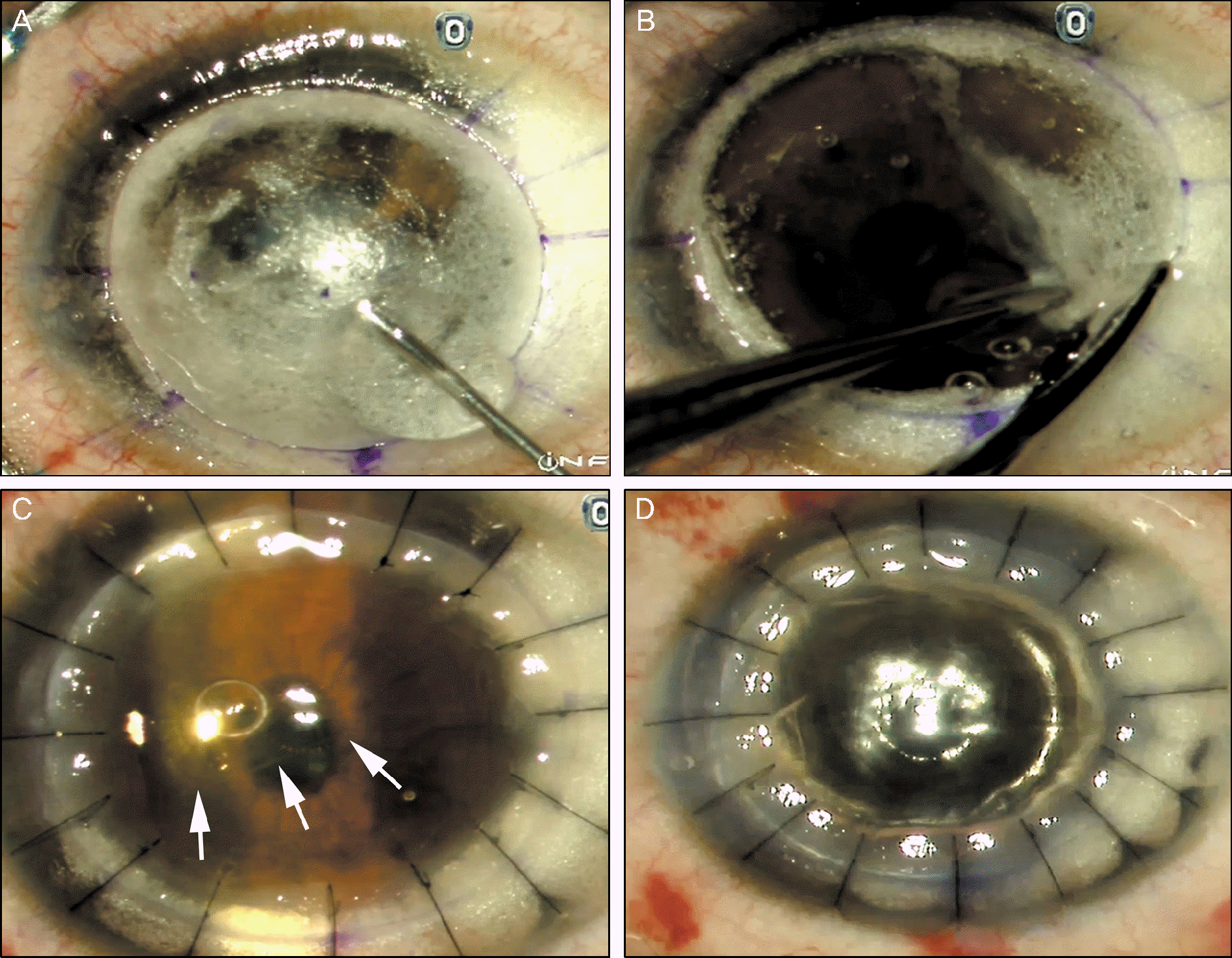Abstract
Purpose
To report a case of double Descemet’s membrane in a patient who had penetrating keratoplasty after rupture of Descemet’s membrane during deep anterior lamellar keratoplasty (DALK).
Case summary
A 24-year-old female had keratoconus in her right eye and underwent DALK for treatment. Descemet’s membrane was ruptured while separating the corneal stroma from Descemet’s membrane with the big bubble technique. The operation method was changed from DALK to penetrating keratoplasty. Detached Descemet’s membrane was observed in the anterior chamber after suturing. Sterile air was injected into the anterior chamber to attach the Descemet’s membrane. Five days after the surgery, Descemet’s membrane was detached and a second air injection was performed. Corneal edema was improved but Descemet’s membrane was re-detached. Double Descemet’s membrane was observed by anterior segment optical coherence tomography (OCT). The detached Descemet’s membrane originated from the re-cipient’s cornea and not from the donor’s cornea. Detached Descemet’s membrane was removed successfully. Patient’s cornea was clear and best corrected visual acuity was 20/25.
Conclusions
When penetrating keratoplasty is performed instead of DALK, the surgeon should completely remove the remnant corneal stroma and Descemet’s membrane. Remnant Descemet’s membrane can be disregarded as it comes from the donor cornea. Unnecessary anterior chamber air injection causes endothelial damage. Anterior segment OCT is a useful tool to identify anatomical structures of transplanted cornea.
References
1. Edrington TB, Szczotka LB, Barr JT, et al. Rigid contact lens fitting relationships in keratoconus. Collaborative Longitudinal Evaluation of Keratoconus (CLEK) Study Group. Optom Vis Sci. 1999; 76:692–9.
2. Wollensak G, Spoerl E, Seiler T. Riboflavin/ultraviolet-a-induced collagen crosslinking for the treatment of keratoconus. Am J Ophthalmol. 2003; 135:620–7.

3. Doh SH, Kim MS. Influence of preoperative corneal thickness to postoperative astigmatism and endothelial cell in keratoconus penetrating keratoplasty. J Korean Ophthalmol Soc. 2005; 46:1978–82.
4. Amayem AF, Anwar M. Fluid lamellar keratoplasty in keratoconus. Ophthalmology. 2000; 107:76–9. discussion 80.
5. Soong HK, Katz DG, Farjo AA, et al. Central lamellar keratoplasty for optical indications. Cornea. 1999; 18:249–56.

6. Archila EA. Deep lamellar keratoplasty dissection of host tissue with intrastromal air injection. Cornea. 1984-1985; 3:217–8.

7. Shimazaki J, Shimmura S, Ishioka M, Tsubota K. Randomized clinical trial of deep lamellar keratoplasty vs penetrating keratoplasty. Am J Ophthalmol. 2002; 134:159–65.
8. Tsubota K, Kaido M, Monden Y, et al. A new surgical technique for deep lamellar keratoplasty with single running suture adjustment. Am J Ophthalmol. 1998; 126:1–8.

9. Anwar M, Teichmann KD. Deep lamellar keratoplasty: surgical techniques for anterior lamellar keratoplasty with and without baring of Descemet's membrane. Cornea. 2002; 21:374–83.
10. Fogla R, Padmanabhan P. Results of deep lamellar keratoplasty using the big-bubble technique in patients with keratoconus. Am J Ophthalmol. 2006; 141:254–9.

11. van Dooren BT, Mulder PG, Nieuwendaal CP, et al. Endothelial cell density after deep anterior lamellar keratoplasty (Melles technique). Am J Ophthalmol. 2004; 137:397–400.

12. Sugita J, Kondo J. Deep lamellar keratoplasty with complete removal of pathological stroma for vision improvement. Br J Ophthalmol. 1997; 81:184–8.

13. Fontana L, Parente G, Tassinari G. Clinical outcomes after deep anterior lamellar keratoplasty using the big-bubble technique in patients with keratoconus. Am J Ophthalmol. 2007; 143:117–24.

14. Smadja D, Colin J, Krueger RR, et al. Outcomes of deep anterior lamellar keratoplasty for keratoconus: learning curve and advan-tages of the big bubble technique. Cornea. 2012; 31:859–63.
16. Hong A, Caldwell MC, Kuo AN, Afshari NA. Air bubble-associated endothelial trauma in descemet stripping automated endothelial keratoplasty. Am J Ophthalmol. 2009; 148:256–9.

17. Minasian M, Ayliffe W. Fixed dilated pupil following deep lamellar keratoplasty (Urrets-Zavalia syndrome). Br J Ophthalmol. 2002; 86:115–6.

18. Maurino V, Allan BD, Stevens JD, Tuft SJ. Fixed dilated pupil (Urrets-Zavalia syndrome) after air/gas injection after deep lamellar keratoplasty for keratoconus. Am J Ophthalmol. 2002; 133:266–8.

Figure 1.
(A) Big bubble technique to separate corneal stroma and Descemet’s membrane. (B) To convert to penetrating keratoplasty, remnant corneal tissue was removed. (C) After completing corneal sutures, detached Descemet’s membrane (white arrows) was observed. (D) Sterile air was injected to attach Descemet’s membrane.

Figure 2.
(A) Postoperative slit-lamp photograph. Although the Descemet’s membrane was still detached (white arrow), the graft got clear. (B) Anterior segment OCT image showed that the detached Descemet’s membrane was originated not from donor but from recipient. (C) Double Descemet’s membrane was removed successfully.





 PDF
PDF ePub
ePub Citation
Citation Print
Print


 XML Download
XML Download